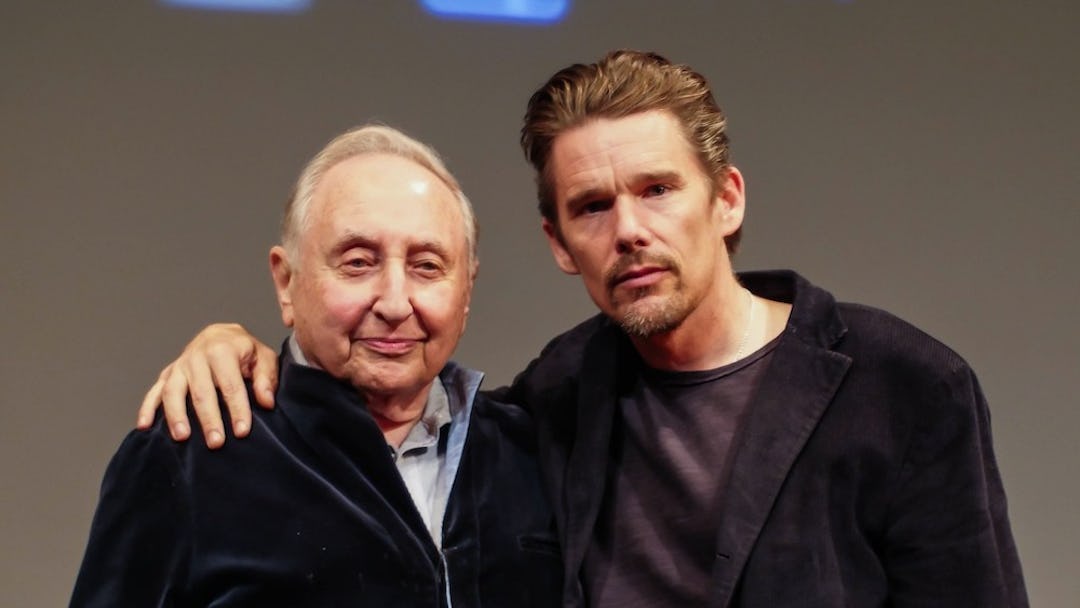Here’s the thing that’s easy to forget about Ethan Hawke: less than a decade ago, he was James Franco. For a generation (specifically, a generation typically signified with an X), he would always be the cynical, unwashed, flannel-wearing would-be alt-rocker of 1993’s Reality Bites, and much out his output following that film seemed the product of a carefully cultivated Serious Artist image. Acting wasn’t enough; he wrote bad books and turned them into bad movies. But as with Franco, the thinness of his other ventures and the caricature he could so easily lapse into made it easy to forget that there was a very fine actor behind all that other nonsense. And over the past few years (with no small assist from his longtime collaborator Richard Linklater), Hawke has realigned and matured, as both actor and screenwriter, remaking himself as one of indie film’s most reliable figures. And now he brings Seymour: An Introduction, which he directed, to this year’s New York Film Festival — and it is not only a very fine documentary, but a warm and likable one to boot.
Its subject is Seymour Bernstein, once a renowned concert pianist, now a teacher and, it seems, full-time mensch. He gives lessons, composes, teachers master classes, and (most importantly) plays and practices. He’s a very good storyteller, recalling his tour of the front lines of the Korean War and his years of public playing, which ceased when he turned 50. It seems a decision he was happy to make, yet remains troubled by, prompting some welcome and thoughtful dialogue on the importance of craft, the integration of person and performer, and an artist’s dual responsibility to their art and to themselves.
And this is where his interests dovetail with those of Mr. Hawke, who appears occasionally in the documentary, in both on- and off-screen conversation with his subject. “I’ve been struggling lately with why I do what I do,” he confesses, and over the course of the film, he and Bernstein discuss Hawke’s stage fright, “the connection between the monsters and the gift,” and the eternal struggle of art vs. commerce. Discussing the project at a press conference following Seymour’s New York Film Festival press screening, Hawke said he took as his model the Rolling Stone profiles he grew up reading, “the best of the Cameron Crowe profiles, where he was a character in it… I was always more taken when I understood why the writer wanted to write this.” Early on, he discovered that “why I wanted to do it should probably be a part of it too, it might be an interesting part of the movie. Because I think it makes it clear that we’re not just talking about the piano.”
Remarkably — and this is a considerable achievement, all things considered — such considerations don’t make the film seem self-indulgent, like Hawke is inserting himself into a story or making Seymour’s narrative about him. It’s partially due to his obviously genuine enthusiasm for his subject; it’s mostly because Seymour comes across as a Buddha-like figure, whose wisdom is best exemplified by how he guides and advises others. Hawke explained that he was drawn to the master/pupil relationship of Bernstein’s piano lessons, because “one of the things I find so hard about middle age is, where are your mentors? When you’re a kid, mentors are all seeking you out, and everybody’s full of advice. And then you get to a certain age, and everyone’s expecting you to be your own mentor. And of course you can be, and there’s a place for that.” But, Hawke says, Seymour told him, “You need a master in your life to tell you, are you working hard, are you applying yourself, and sometimes even if you’re doing it with all the right intentions, you still might fall on your face — but it might be in the service of your long-term growth.”
And perhaps that’s the best way to look at some of Hawke’s less-successful endeavors, which may not have worked in and of themselves, but led him to the point where he could co-write something as insightful as Before Midnight or direct something like Seymour: An Introduction, which is a lovely film, thoughtful and modest (in the best possible sense: brief, intimate, and true). Hawke shows real skill as a documentarian: He’s got a good eye and a crisp style, his archival footage is well-chosen and sparingly used, he moves between scenes and ideas gracefully and seamlessly, and there’s a real elegance to the film, one which seems to key off its subject.
Yet fascinatingly, this diversion may have led Hawke back to his initial course. “I was looking for some grand secret,” he told me Friday. “You know when you’re really struggling for something, you think the answer’s gonna be, ‘You need to go to Arizona and take peyote and jump over the moon and turn around three times and find a magic salt container and take it to your place of birth and pee in the river, and then you’re gonna feel better.’ And instead, it’s like ‘You could try acting,’ which I’ve been doing since I was 13. It’s a very obvious moment of what the whole movie’s about, which is integrating your life — that I can figure it out just by the means that are in front of me.”
Seymour: An Introduction screens Saturday, September 27 and Monday, September 29 at the New York Film Festival. Images courtesy of the Film Society of Lincoln Center.
